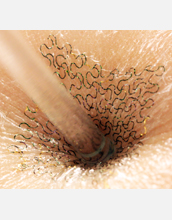All Images
News Release 11-163
Stick-On Tattoos Go Electric
Micro-electronics, elegant design and existing tattoo tech combine to create a complex device that is far more than a novelty
This material is available primarily for archival purposes. Telephone numbers or other contact information may be out of date; please see current contact information at media contacts.

The newly developed device, an epidermal electronic system created by an international team of engineers and scientists.
Credit: J. Rogers, University of Illinois
Download the high-resolution JPG version of the image. (6.3 MB)
Use your mouse to right-click (Mac users may need to Ctrl-click) the link above and choose the option that will save the file or target to your computer.
On August 10, 2011, NSF interviewed University of Illinois professor John Rogers about a novel electronic tattoo.
Credit: NSF
Northwestern University professor Yonggang Huang describes how he and his collaborators developed the new electronic tattoo.
Credit: NSF
One of the advantages of the newly created epidermal electronic systems is easy on / easy off application. As this video shows, the electronics have the right physical propertie--such as stiffness, bending rigidity, thickness and mass density--to perfectly match to the epidermis. The systems seamlessly integrate and conform to the surface of the skin in a way that is mechanically invisible to the user, and the devices have the potential to provide a range of healthcare and non-healthcare related functions.
Credit: J. Rogers, University of Illinois

A newly developed stick-on tattoo with integrated sensor technology, prior to application (from reverse).
Credit: J. Rogers, University of Illinois
Download the high-resolution JPG version of the image. (6.8 MB)
Use your mouse to right-click (Mac users may need to Ctrl-click) the link above and choose the option that will save the file or target to your computer.

When compressed and pulled, the epidermal electronics device conforms with the skin, remaining in place and intact.
Credit: J. Rogers, University of Illinois
Download the high-resolution JPG version of the image. (2.5 MB)
Use your mouse to right-click (Mac users may need to Ctrl-click) the link above and choose the option that will save the file or target to your computer.

The undulating wiring developed by the research teams which enables electronics strength and flexibility despite small size.
Credit: J. Rogers, University of Illinois
Download the high-resolution JPG version of the image. (549 KB)
Use your mouse to right-click (Mac users may need to Ctrl-click) the link above and choose the option that will save the file or target to your computer.

The researchers' work is described in the August 12, 2011 issue of the journal Science.
Credit: Copyright AAAS 2011
Download the high-resolution JPG version of the image. (525 KB)
Use your mouse to right-click (Mac users may need to Ctrl-click) the link above and choose the option that will save the file or target to your computer.
